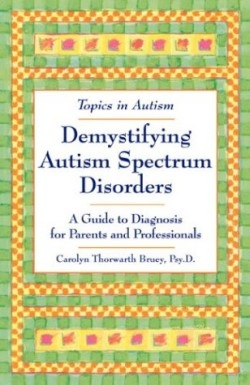Demystifying Autism Spectrum Disorders
A Guide to Diagnosis for Parents and Professionals
Parents who have children on the autism spectrum usually start out with a “normal” child. Their shock comes slowly, as their typical-looking child loses skills like talking; shows little interest in people; avoids eye contact; or in some cases, severely regresses.
After months and sometimes years of wondering what is wrong with their child, parents get a diagnosis that their child has an autism spectrum disorder, or ASD. Though they may accept the label, they need a great deal of information to understand the definition, the prognosis, and the treatment. There is still no known cause for ASD and treatment crosses a wide spectrum. This new release from Woodbine, a publisher specializing in books about special needs, offers parents and professionals clear and current information and treatment options for ASD.
As the understanding and definition of ASD is refined and researched, the need for a comprehensive discussion has grown. In many ways, ASD is articulately defined, though it is still a difficult diagnosis to make. The author has worked with autistic people for more than twenty years. She has written chapters for several books, including Children with Autism: A Parent’s Guide, and is a managing partner of a disabilities resource center. Here, she speaks with experience and compassion.
Her nine chapters offer a logical discussion nicely exemplified with real-life stories. Writing intelligently without being patronizing or overly academic, Bruey examines ADS carefully, including the myths, demographics, and theories of cause. Not long ago, doctors blamed parents for their children’s condition.
The author also discusses the criteria and features of the five autism spectrum disorders as well as an explanation of the diagnostic process. ASD is determined solely by defining behavioral clusters. The last two chapters explore the current treatment choices, such as Applied Behavior Analysis (ABA), social stories, medication, and alternative treatments. While she briefly presents options such as diet therapy, Bruey states that no independent research studies have proven their benefits. She does admit that there is a growing body of anecdotal evidence and implies a need for further study: “Knowledge regarding autism spectrum disorders continues to grow such that new theories about cause and treatments are being developed on an ongoing basis.”
The number of children with ASD is rising. Current statistics indicate that as many as “1 in every 500 children fall within the spectrum.” That translates to a high need for educators and the general public—as well as professionals and parents—to have a greater understanding of ASD. This definitive manual truly demystifies autism spectrum disorders.
Reviewed by
Anna Stewart
Disclosure: This article is not an endorsement, but a review. The publisher of this book provided free copies of the book to have their book reviewed by a professional reviewer. No fee was paid by the publisher for this review. Foreword Reviews only recommends books that we love. Foreword Magazine, Inc. is disclosing this in accordance with the Federal Trade Commission’s 16 CFR, Part 255.

